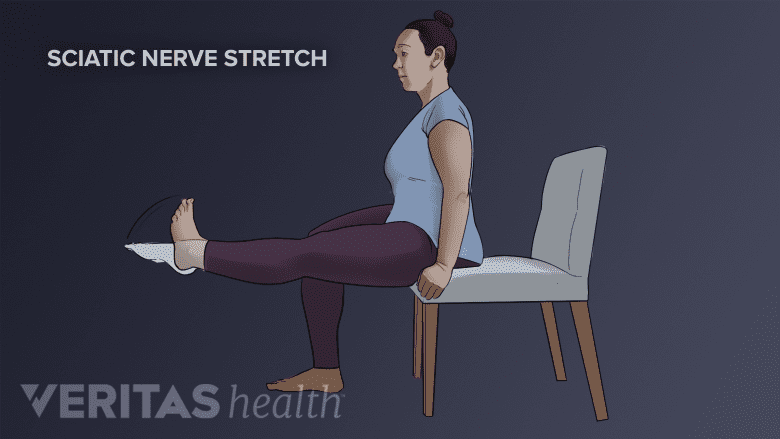The irritation or compression of a nerve root in your lower spine can result in sciatica, typically felt as searing pain along your thigh, possibly extending into your leg and foot. Sciatica symptoms may be persistent and chronic or may flare up intermittently. Severe sciatica can be problematic—especially when you’re at the office and have to complete a full day of work.
The most common cause of sciatica is a herniated or bulging disc in your lower back.1Davis D, Maini K, Vasudevan A. Sciatica. [Updated 2020 Jan 25]. In: StatPearls [Internet]. Treasure Island (FL): StatPearls Publishing; 2020 Jan-. Available from: https://www.ncbi.nlm.nih.gov/books/NBK507908/,3Xiang A, Xu M, Liang Y, Wei J, Liu S. Immediate relief of herniated lumbar disc-related sciatica by ankle acupuncture: A study protocol for a randomized controlled clinical trial. Medicine (Baltimore). 2017;96(51):e9191. doi:10.1097/MD.0000000000009191 To help shift your focus off your pain and back to your job, here’s a guide to finding sciatica relief from a herniated or bulging disc while you’re at the office.
Read more about Sciatica Causes
Switch to a standing desk at regular intervals
When you sit, the stresses on the spinal discs in your lower back can increase up to 40%.4Amin RM, Andrade NS, Neuman BJ. Lumbar Disc Herniation. Curr Rev Musculoskelet Med. 2017;10(4):507–516. doi:10.1007/s12178-017-9441-4 For this reason, extended periods of sitting may cause your discs to irritate your sciatic nerve roots, aggravating your sciatica.
To help relieve the stress around the nerve roots in your lower back, try using a standing desk. Standing is an active process, and following an ergonomically supported standing posture can help relieve stresses on your lower back and minimize sciatica pain from a herniated or bulged disc. Aim to switch between a seated and standing posture intermittently during your workday. Gradually work your way up to longer periods of standing.
Take a short walk every hour
Spinal discs receive nutrition through the movement of fluids that occurs during exercise, which also increases blood flow. Research suggests that light exercise, such as walking, may help improve the transportation of nutritive fluids to the disc and improve the disc’s ability to adapt to spinal loads.5Hendrick P, Te Wake AM, Tikkisetty AS, Wulff L, Yap C, Milosavljevic S. The effectiveness of walking as an intervention for low back pain: a systematic review. Eur Spine J. 2010;19(10):1613–1620. doi:10.1007/s00586-010-1412-z
When your work requires long periods at your desk, try to get up every hour and walk a short distance. Take slow, deep breaths and use a correct walking posture. Adding a recurring alarm on your phone or computer that prompts you to take a break and walk every hour may be helpful.
See 2 Walking Tips to Avoid Sciatica Pain
Try the seated nerve glide exercise

The sciatic nerve glide exercise helps relax and desensitize the sciatic nerve, improving the range of motion in the leg(s).
A useful exercise for herniated discs that can be performed while you’re seated in your office is the nerve glide exercise. This exercise helps relax and desensitize your sciatic nerve. To perform this exercise:
- Sit upright on a chair and straighten one knee while keeping your other foot flat on the floor.
- Slowly bend your ankle so that your toes are pointing towards you.
- Continue to bend your ankle back and forth, pointing your toes away from you and then toward you.
- As tolerated, to put more tension on the sciatic nerve, try the same nerve glide with your head bent forward, bringing your chin toward your chest.
Pump your ankle up and down 15 to 20 times and then repeat the exercise with your other leg. Aim to complete 3 rounds for each leg, twice a day.
If your sciatica symptoms continue to severely interfere with your workdays, consult your doctor for an in-depth diagnostic checkup. Your doctor may recommend medical treatment options, such as a guided physical therapy program, prescription pain medications, and/or lumbar epidural steroid injections.
Learn more:
- 1 Davis D, Maini K, Vasudevan A. Sciatica. [Updated 2020 Jan 25]. In: StatPearls [Internet]. Treasure Island (FL): StatPearls Publishing; 2020 Jan-. Available from: https://www.ncbi.nlm.nih.gov/books/NBK507908/
- 3 Xiang A, Xu M, Liang Y, Wei J, Liu S. Immediate relief of herniated lumbar disc-related sciatica by ankle acupuncture: A study protocol for a randomized controlled clinical trial. Medicine (Baltimore). 2017;96(51):e9191. doi:10.1097/MD.0000000000009191
- 4 Amin RM, Andrade NS, Neuman BJ. Lumbar Disc Herniation. Curr Rev Musculoskelet Med. 2017;10(4):507–516. doi:10.1007/s12178-017-9441-4
- 5 Hendrick P, Te Wake AM, Tikkisetty AS, Wulff L, Yap C, Milosavljevic S. The effectiveness of walking as an intervention for low back pain: a systematic review. Eur Spine J. 2010;19(10):1613–1620. doi:10.1007/s00586-010-1412-z

